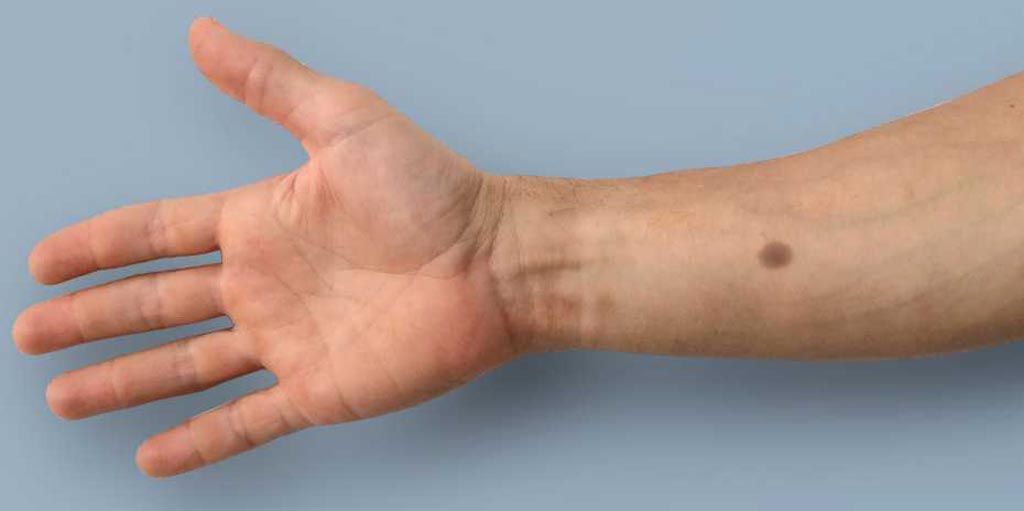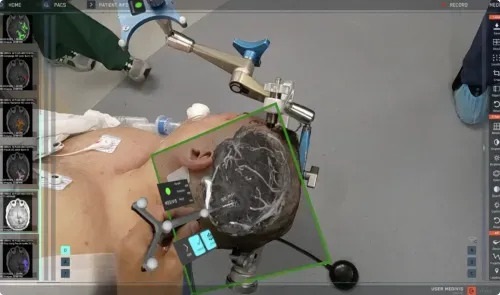Biomedical Tattoo Detects Cancer-Associated Hypercalcemia
|
By HospiMedica International staff writers Posted on 01 May 2018 |

Image: A new study explains how increased calcium levels trigger the production of melanin, causing a mole to form (Photo courtesy of ETH Zurich).
A new study describes how a mole-like synthetic implant recognizes the elevated levels of calcium in the blood associated with incipient prostate, lung, colon, and breast cancer tumors.
Developed by researchers at ETH Zurich (Switzerland) and the University of Basel (Switzerland), the so-called early warning system is comprised of an encapsulated gene network integrated into human body cells implanted under the skin, where it constantly monitors blood calcium levels. When calcium levels exceed a pre-determined threshold, a synthetic signaling cascade expresses transgenic tyrosinase, which triggers the production of melanin in the genetically modified cells. The skin then forms a brown mole that is visible to the naked eye.
The researchers validated the design in wild-type mice inoculated with hypercalcemic breast and colon adenocarcinoma cells. The mice, which were implanted with the subcutaneous encapsulated engineered cells, all developed tattoos, whereas no tattoos were seen in animals inoculated with normo-calcemic tumor cells. The study also confirmed that the synthetic biomedical mole could not only be detected with the naked eye, but could also optically quantified. All animals remained asymptomatic throughout the 38-day experimental period. The study was published on April 18, 2018, in Science Translational Medicine.
“It recognizes the four most common types of cancer--prostate, lung, colon, and breast cancer--at a very early stage, namely when the level of calcium in the blood is elevated due to the developing tumor,” said senior author Professor Martin Fussenegger, PhD, of the ETH department of biosystems science and engineering. “An implant carrier should then see a doctor for further evaluation after the mole appears. It is no reason to panic; the mole does not mean that the person is likely to die soon.”
“It is intended primarily for self-monitoring, making it very cost effective. However, for those who would prefer not to deal with the constant stress, an implant can also be used that develops a mark visible only under a red light,” concluded Professor Fussenegger. “The disadvantage is that the service life of such an implant is limited. Encapsulated living cells last for about a year, according to other studies. After that, they must be inactivated and replaced.”
Calcium is an essential element vital to the health of the muscular, circulatory, and digestive systems; is indispensable to the building of bone; and supports synthesis and function of blood cells. For example, it regulates the contraction of muscles, nerve conduction, and the clotting of blood. As a result, intra- and extracellular calcium levels are tightly regulated by the body. Cancer can cause hypercalcemia by bone degradation, releasing excess calcium into the blood; some tumors can produce proteins that mimic parathyroid hormone; and others can affect the ability of the kidneys to remove excess calcium.
Related Links:
ETH Zurich
University of Basel
Developed by researchers at ETH Zurich (Switzerland) and the University of Basel (Switzerland), the so-called early warning system is comprised of an encapsulated gene network integrated into human body cells implanted under the skin, where it constantly monitors blood calcium levels. When calcium levels exceed a pre-determined threshold, a synthetic signaling cascade expresses transgenic tyrosinase, which triggers the production of melanin in the genetically modified cells. The skin then forms a brown mole that is visible to the naked eye.
The researchers validated the design in wild-type mice inoculated with hypercalcemic breast and colon adenocarcinoma cells. The mice, which were implanted with the subcutaneous encapsulated engineered cells, all developed tattoos, whereas no tattoos were seen in animals inoculated with normo-calcemic tumor cells. The study also confirmed that the synthetic biomedical mole could not only be detected with the naked eye, but could also optically quantified. All animals remained asymptomatic throughout the 38-day experimental period. The study was published on April 18, 2018, in Science Translational Medicine.
“It recognizes the four most common types of cancer--prostate, lung, colon, and breast cancer--at a very early stage, namely when the level of calcium in the blood is elevated due to the developing tumor,” said senior author Professor Martin Fussenegger, PhD, of the ETH department of biosystems science and engineering. “An implant carrier should then see a doctor for further evaluation after the mole appears. It is no reason to panic; the mole does not mean that the person is likely to die soon.”
“It is intended primarily for self-monitoring, making it very cost effective. However, for those who would prefer not to deal with the constant stress, an implant can also be used that develops a mark visible only under a red light,” concluded Professor Fussenegger. “The disadvantage is that the service life of such an implant is limited. Encapsulated living cells last for about a year, according to other studies. After that, they must be inactivated and replaced.”
Calcium is an essential element vital to the health of the muscular, circulatory, and digestive systems; is indispensable to the building of bone; and supports synthesis and function of blood cells. For example, it regulates the contraction of muscles, nerve conduction, and the clotting of blood. As a result, intra- and extracellular calcium levels are tightly regulated by the body. Cancer can cause hypercalcemia by bone degradation, releasing excess calcium into the blood; some tumors can produce proteins that mimic parathyroid hormone; and others can affect the ability of the kidneys to remove excess calcium.
Related Links:
ETH Zurich
University of Basel
Latest Health IT News
- Machine Learning Model Improves Mortality Risk Prediction for Cardiac Surgery Patients
- Strategic Collaboration to Develop and Integrate Generative AI into Healthcare
- AI-Enabled Operating Rooms Solution Helps Hospitals Maximize Utilization and Unlock Capacity
- AI Predicts Pancreatic Cancer Three Years before Diagnosis from Patients’ Medical Records
- First Fully Autonomous Generative AI Personalized Medical Authorizations System Reduces Care Delay
- Electronic Health Records May Be Key to Improving Patient Care, Study Finds
- AI Trained for Specific Vocal Biomarkers Could Accurately Predict Coronary Artery Disease
- First-Ever AI Test for Early Diagnosis of Alzheimer’s to Be Expanded to Diagnosis of Parkinson’s Disease
- New Self-Learning AI-Based Algorithm Reads Electrocardiograms to Spot Unseen Signs of Heart Failure
- Autonomous Robot Performs COVID-19 Nasal Swab Tests

- Statistical Tool Predicts COVID-19 Peaks Worldwide
- Wireless-Controlled Soft Neural Implant Stimulates Brain Cells
- Tiny Polymer Stent Could Treat Pediatric Urethral Strictures
- Human Torso Simulator Helps Design Brace Innovations
- 3D Bioprinting Rebuilds the Human Heart
Channels
Artificial Intelligence
view channel
AI-Powered Algorithm to Revolutionize Detection of Atrial Fibrillation
Atrial fibrillation (AFib), a condition characterized by an irregular and often rapid heart rate, is linked to increased risks of stroke and heart failure. This is because the irregular heartbeat in AFib... Read more
AI Diagnostic Tool Accurately Detects Valvular Disorders Often Missed by Doctors
Doctors generally use stethoscopes to listen for the characteristic lub-dub sounds made by heart valves opening and closing. They also listen for less prominent sounds that indicate problems with these valves.... Read moreCritical Care
view channel.jpeg)
Transcatheter Valve Replacement Outcomes Similar To Surgery, Finds Study
A new study has shown that a minimally invasive procedure for replacing the aortic valve in the heart—known as transcatheter aortic valve replacement (TAVR)—is on par with the more traditional surgical... Read more
Revascularization Improves Life Quality in Chronic Limb-Threatening Ischemia, Finds Study
Researchers have undertaken a detailed study to evaluate the effects of revascularization strategies on the health-related quality of life (HRQoL) of patients with chronic limb-threatening ischemia.... Read moreSurgical Techniques
view channel
AR Surgical Technology Translates Complex 2D Medical Imaging to Enhance Accuracy
Surgeons often have to switch their focus between a patient’s data displayed on a screen or clipboard and the patient themselves during procedures. But that is about to change. Surgeons can now utilize... Read more
Miniaturized Snake-Like Probe Images Cerebral Arteries From Within
Endovascular interventions are being increasingly favored for treating strokes and cerebral artery diseases, but rely heavily on angiographical imaging that often struggles with limited contrast and spatial... Read morePatient Care
view channelFirst-Of-Its-Kind Portable Germicidal Light Technology Disinfects High-Touch Clinical Surfaces in Seconds
Reducing healthcare-acquired infections (HAIs) remains a pressing issue within global healthcare systems. In the United States alone, 1.7 million patients contract HAIs annually, leading to approximately... Read more
Surgical Capacity Optimization Solution Helps Hospitals Boost OR Utilization
An innovative solution has the capability to transform surgical capacity utilization by targeting the root cause of surgical block time inefficiencies. Fujitsu Limited’s (Tokyo, Japan) Surgical Capacity... Read more
Game-Changing Innovation in Surgical Instrument Sterilization Significantly Improves OR Throughput
A groundbreaking innovation enables hospitals to significantly improve instrument processing time and throughput in operating rooms (ORs) and sterile processing departments. Turbett Surgical, Inc.... Read morePoint of Care
view channel
Critical Bleeding Management System to Help Hospitals Further Standardize Viscoelastic Testing
Surgical procedures are often accompanied by significant blood loss and the subsequent high likelihood of the need for allogeneic blood transfusions. These transfusions, while critical, are linked to various... Read more
Point of Care HIV Test Enables Early Infection Diagnosis for Infants
Early diagnosis and initiation of treatment are crucial for the survival of infants infected with HIV (human immunodeficiency virus). Without treatment, approximately 50% of infants who acquire HIV during... Read more
Whole Blood Rapid Test Aids Assessment of Concussion at Patient's Bedside
In the United States annually, approximately five million individuals seek emergency department care for traumatic brain injuries (TBIs), yet over half of those suspecting a concussion may never get it checked.... Read more
New Generation Glucose Hospital Meter System Ensures Accurate, Interference-Free and Safe Use
A new generation glucose hospital meter system now comes with several features that make hospital glucose testing easier and more secure while continuing to offer accuracy, freedom from interference, and... Read moreBusiness
view channel
Johnson & Johnson Acquires Cardiovascular Medical Device Company Shockwave Medical
Johnson & Johnson (New Brunswick, N.J., USA) and Shockwave Medical (Santa Clara, CA, USA) have entered into a definitive agreement under which Johnson & Johnson will acquire all of Shockwave’s... Read more


















